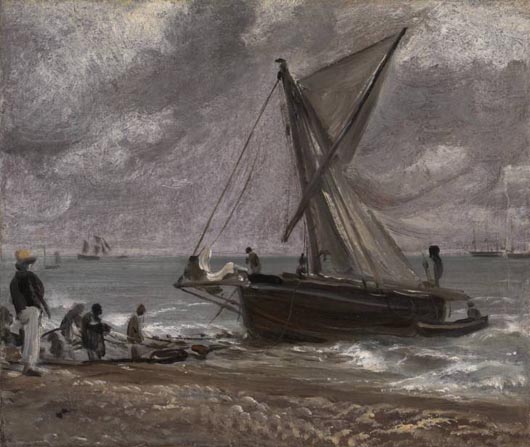News:
Tate to return painting by Constable to Hungarian collector’s heirs
By Martin Bailey
Advisory panel criticises museum for failing to investigate work’s history
Going back to baron's heirs: Constable's Beaching a Boat, Brighton, 1824
Tate is to restitute a painting by Constable, which was looted from a Hungarian collector during the Second World War. This follows a report by the UK’s Spoliation Advisory Panel, which recommended today, 26 March, that the museum return Beaching a Boat, Brighton, 1824, which had been donated to the collection in 1986. In its report, the panel also sternly criticised the museum for not thoroughly researching the work’s history.
The claimants requested anonymity and the panel’s report does not name the collector, describing him as a “well-known Hungarian artist and connoisseur, whose family had amassed considerable wealth through banking and industrial activities”. However, shortly before the report was published, we revealed that the collector was the Budapest-based Baron Ferenc Hatvany (The Art Newspaper, April 2014, pp1, 6), who was of Jewish origin. Hatvany’s heirs discovered two years ago that that the painting by Constable had ended up in Tate’s collection, where it has a slightly different title; in April 2013, a claim was formally submitted to the spoliation panel.
Hatvany had bought Beaching a Boat, Brighton at a Paris auction in 1908. In 1942, when Budapest was threatened with Allied bombing, he put many of his paintings in bank vaults for protection, although other pictures remained in his two main residences. Two years later, after the German invasion of Hungary, Hatvany went into hiding, where he remained until Soviet troops entered the country in February 1945. At that point, Red Army soldiers looted the bank vaults.
Beaching a Boat, Brighton was donated to Tate in 1986 by a Mrs P.M. Rainsford, who had acquired it in 1962. That same year, it was owned by a Mr Meyer, who sold it to the London dealer Leger, and it then went to the Broadway Art Gallery in Worcestershire, which sold it to Rainsford. All parties appear to have been acting in good faith.
The panel, which was set up by the UK government to examine Nazi-era spoliation claims and make recommendations, concluded that the Constable was with the Hungarian owner in 1944. It was then “taken in the course of anti-Semitic persecution of the collector and his family by the German occupying forces either from one of his homes or from a bank vault”. The heirs “therefore have a strong moral claim for the restitution of the painting”.
The panel was very critical of Tate’s failure to investigate the Constable’s provenance. It concluded that the gallery was “under a moral obligation to pursue the possibility that the painting had been the object of spoliation”, and the panel said it was “surprising” that Tate had not examined the work, since it had an unclear provenance between 1933 to 1945. “It would not have been difficult to have made enquires of the Hungarian government, [which] included the painting on its official [1998] list of looted art from the late 1940s,” the report says.
The panel also accuses Tate of withholding information about the work from the heirs. Although the museum was not legally required to disclose all the evidence it has, Tate “asserts that it had ‘provided the Claimants with all the material relating to the specific issues they had raised’ but this makes it clear that there is material with which it has not provided them. If the Claimants wished to see it, they should surely have been able to do so.”
Tate issued a statement today saying it is “pleased to follow the conclusions” of the panel. It will therefore recommend to the gallery’s trustees, when they meet in May, that the Constable should be returned to the claimants.


